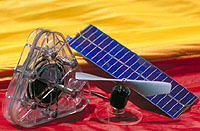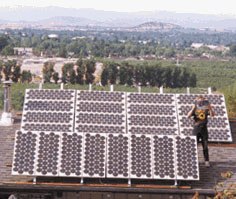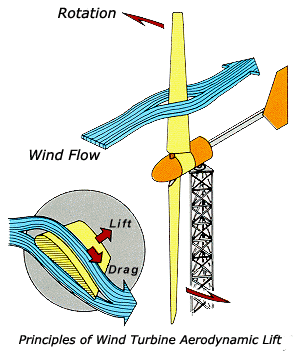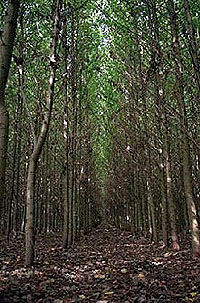
 |
| Contents | |
| I. | Introduction |
| II. | Solar Power |
| III. | Wind Energy |
| IV. | Biomass Energy |
Introduction
A wide variety of alternative energy sources have been developed and are
in use throughout the world. We have not yet perfected the fuel cell,
but we do have other viable alternatives while we're waiting.
Solar Power
The sun's rays can be captured by solar panels and saved for a rainy day.
On a clear, sunny day, the sun can provide 1,000 watts per square meter
on the earth's surface. Solar power can be used to provide electricity,
and also to heat buildings. For large office buildings, this could potentially
mean saving hundreds of thousands of dollars in winter heating costs.
Solar panels are made up of photovoltaic cells. These cells are made up
of semiconducting materials like silicon. When light hits the solar panel,
energy from the sun knocks electrons loose within the cell. Metal contacts
attached to the panel keep the electrons flowing in the proper direction,
and this electrical energy is harnessed through wires and batteries. By
connecting multiple cells in series (or in parallel), greater power can
be obtained from the sun.
By wiring the cells in series, greater voltage is achieved; by wiring
them in parallel, greater amperage is obtained and the voltage remains
the same.
 |
|
This
solar array provides 2,400 watts of power!
[Home Power Magazine] |
More information on solar power and links to various companies providing products and consultation is available here.
 |
With wind power, a turbine rotates when the wind blows. This turns a system of gears, and the gears send the power to an electrical generator. Current technology has pushed the efficiency of wind power generators to 20-30%.
There are two concerns with wind turbine use:
Turbines can be very loud in strong winds. One wind power enthusiast says that his turbine sounds like a truck rumbling down a New England dirt road when the winds blow harder than 30 miles per hour.
The other issue with wind turbines is that they kill birds unfortunate enough to fly in their path. However, manufacturers say that new designs and better placement of turbines decreases this risk. Overall, the benefits outweigh the negatives.
More information on wind energy and a list of companies specializing in wind energy products are located here.
 |
Garbage materials such as wood, manure, and crop residues can be burned to release trapped hydrogen and carbon. These materials are known as biomass, and the resulting energy is called biomass energy.
Ever billion gallons of ethanol produced in the US results in the creation of 17,000 jobs, according to the US Department of Agriculture (via the American Biomass Association website). The rural farmer economy will get a great boost if biomass energy is investigated as a primary source of power for the United States.
Biomass will also help to lower US greenhouse gas emissions. By burning biomass, CO2 is released, but it is used again in the growth of other biomass, maintaining a closed cycle. Extensive root structures can capture carbon, actually resulting in a net reduction in CO2!
More information on this renewable resource is available here.